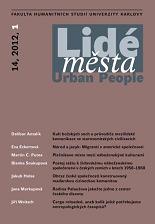Plečnikovo místo mezi náboženskými kulturami
Plečnik’s place between religious Cultures
Author(s): Martin C. PutnaSubject(s): Christian Theology and Religion
Published by: Univerzita Karlova v Praze - Fakulta humanitních studií
Keywords: Plečnik; Jože; Catholic milieu; Masaryk’s philosophy of religion; Slovenia; Vienna
Summary/Abstract: The Slovenian architect Jože Plečnik is known both for his ardent Roman Catholic religiosity as for his work for the Czechoslovak president, liberal religious thinker President Masaryk. Less attention has been paid to the question how these two religious cultures were compatible in his worldviews and his self-reflection. We search for the answer primarily with the help of Plečnik’s correspondence with religious personalities belonging to the Slovenian, the Austrian and the Czech culture, as well as with the help of the memoirs of Plečnik’s pupils and friends. The solution is offered by an analogy to Plečnik’s own architectonical work. His work is based on the principles and motifs of Greek and Roman architecture, but these “inherited” elements are freely modified and combined with elements of a different origin – so his religious worldview is based on beliefs and social stereotypes (and prejudices) of the contemporary Catholic milieu, but again, these elements are freely adapted and combined with other, “heterogeneous”, motifs. This internal freedom makes Plečnik’s enthusiasm plausible both for the Catholic Church and for the “anti-Catholic” President Masaryk. Although Plečnik declares himself to be an artist and a man deeply rooted in traditions – in practice, he creates and thinks as a typically “modern”, individualistic “homo religiosus”.
Journal: Lidé města
- Issue Year: 14/2012
- Issue No: 1
- Page Range: 45-71
- Page Count: 27
- Language: Czech

